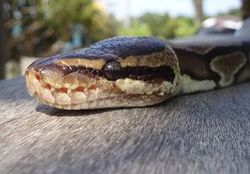Snake Special Senses
| This article has been peer reviewed but is awaiting expert review. If you would like to help with this, please see more information about expert reviewing. |

Chemoreception
The chemosensory system in reptiles is mediated by sensory cells in the nasal cavity and by Jacobson's organ (vomeronasal organ) that is located in the roof of the mouth, caudal to the rostral scales and within the margins of the upper arcade. The tongues brings odoriferous particles to Jacobson's organ, which is innervated by the vomeronasal branch of the olfactory nerve. Receptors may also detect the presence of water. A chemosensory system analogous to taste exists in reptiles where taste buds and sensory papillae are spread throughout the oral mucosa. They are innervated primarily by the glossopharyngeal nerve (cranial nerve IX).
Heat-sensitive receptors
Specialised infrared receptors, the heat-sensitive receptors or pit organs, occur in the labial pits of boidsand pythons, and the heat pits of pit vipers. They are extremely sensitive to small changes in the temperature and are used to locate warm-blooded prey. In captivity they may make the eating of dead prey, especially if frozen, a problem. Ticks and mites are frequently found in the pits of newly imported snakes.
- In pit vipers, one heat sensitive pit organ occurs on each side of the head slightly ventral to a line drawn between the nostril and the eye. It appears that their sensory fields overlap and create heat perception in the three dimensions. They are innervated by the ophthalmic and maxillary branches of the trigenimal nerve.
- Most boids have receptors in pits along the upper labial scales. The morphology of the receptors varies among species. These pits are smaller and simpler than those of the pit vipers and are innervated by the ophthalmic, maxillary and mandibular branches of the trigeminal nerve.
Snake Ear
Snakes have no external evidence of an ear. There is no tympanic membrane or middle ear cavity. The columella, an ossicle, extends from the inner ear to the quadrate bone and may detect vibrations from the ground through the jaw. Snakes may be able to detect airborne low frequency sound (150 to 600 Hz).
- Find out more information on snake physical examinations.
References
Mader, D.R. (2005). Reptile Medicine and Surgery. Saunders. pp. 50. ISBN 072169327X